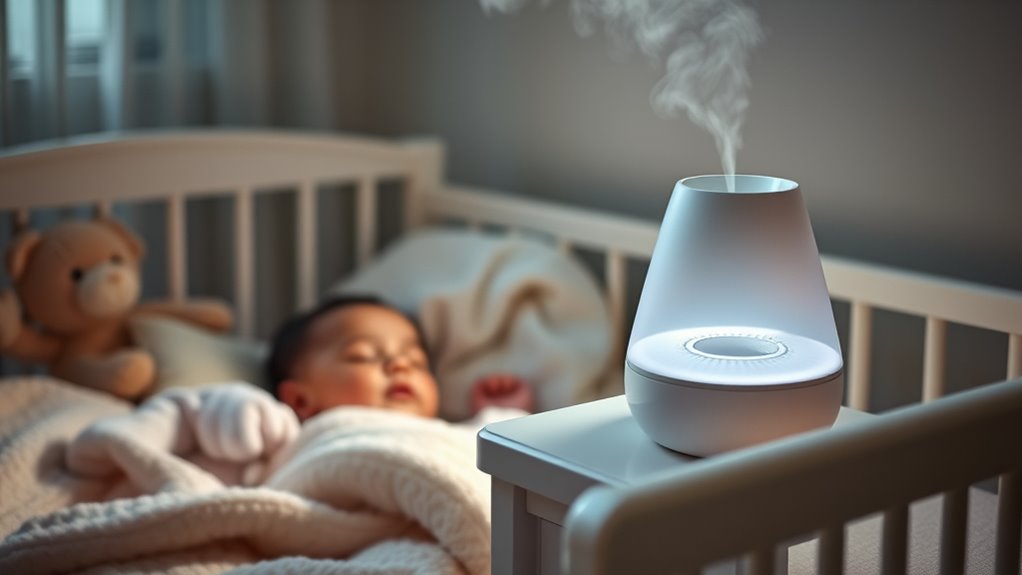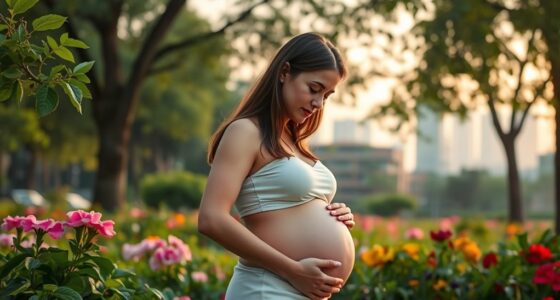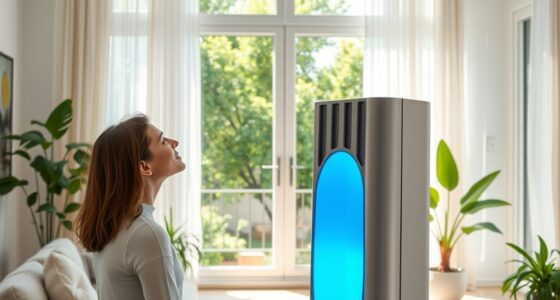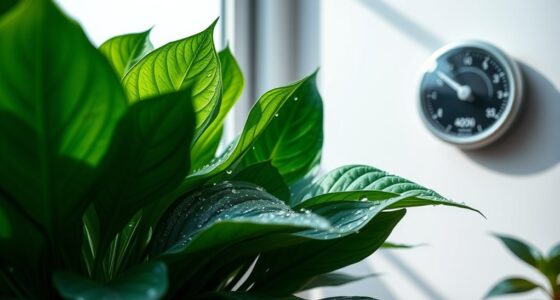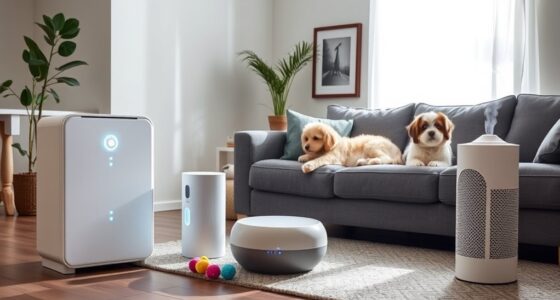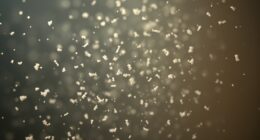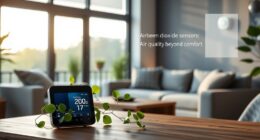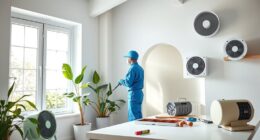To use humidifiers safely for babies and toddlers, clean them regularly with vinegar or disinfectants, and always use distilled or filtered water to prevent bacteria and mineral buildup. Keep humidity levels between 30% and 50%, monitored with a hygrometer, and place the device about three feet from your child’s bed on a flat surface. Choosing the right type—preferably cool-mist— and following safety tips helps create a healthier environment. If you continue, you’ll find helpful steps to guarantee safe and effective use.
Key Takeaways
- Regularly clean and disinfect the humidifier using vinegar or mild disinfectants to prevent mold and bacteria growth.
- Keep humidity levels between 30% and 50% using a hygrometer, adjusting the device as needed.
- Place the humidifier on a flat, elevated surface about three feet from the child’s bed to prevent spills and excess moisture.
- Use cool-mist humidifiers for safety, and supervise children to prevent touching or tampering with the device.
- Use distilled or filtered water to reduce mineral deposits and airborne allergens, ensuring healthier air quality for babies and toddlers.
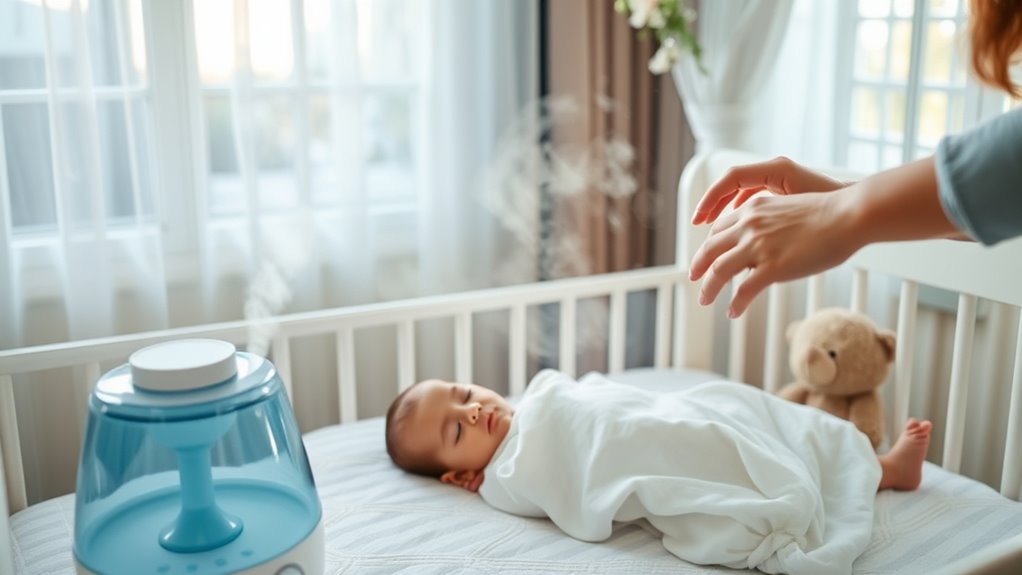
Humidifiers can be a great way to soothe your baby’s or toddler’s dry, irritated airways, but it is vital to use them safely. Proper humidifier maintenance is essential to prevent potential health risks and guarantee your little one benefits from a safe, comfortable environment. Regularly cleaning your humidifier helps prevent mold, bacteria, and mineral buildup that can be dispersed into the air and inhaled by your child. Follow the manufacturer’s instructions for cleaning, usually involving daily rinsing and weekly deep cleans with vinegar or mild disinfectants. Using distilled or filtered water instead of tap water can reduce mineral deposits and airborne particles, keeping the air cleaner and decreasing the chances of allergy symptoms or respiratory issues.
Regularly clean your humidifier and use distilled water to keep your child’s air safe and healthy.
Monitoring humidity levels is another key aspect of safe humidifier use. Aim to keep the room’s humidity between 30% and 50%. Excessively high humidity can promote mold growth and dust mites, leading to allergy symptoms or worsening asthma. Using a hygrometer can help you track humidity levels accurately. If you notice excessive moisture or mold around the humidifier, it’s a sign to reduce the settings or turn the device off until the environment dries out and the unit is thoroughly cleaned. Additionally, incorporating AI technology can help automate humidity control, ensuring optimal levels without constant manual adjustment.
When it comes to allergy prevention, be mindful of the water and the humidifier’s placement. Using clean, bacteria-free water minimizes the chances of airborne allergens. Place the humidifier on a flat, elevated surface and keep it at a safe distance from your child’s bed or crib—typically about three feet away—to prevent direct spray or excess moisture from settling on bedding or furniture. Proper placement helps avoid mold and dust accumulation and reduces the risk of accidental spills or burns.
Additionally, pay attention to the type of humidifier you choose. Cool-mist units are generally safer for children than warm-mist models, which can pose burn hazards. Always turn off and unplug the device before refilling or cleaning it. Keep an eye on your child during use, especially if they’re curious or prone to touching the appliance. By maintaining your humidifier diligently and managing humidity levels, you can create a healthier, allergy-free environment for your baby or toddler. Proper care not only enhances their comfort but also helps prevent respiratory issues caused by poor air quality.
Frequently Asked Questions
Can I Leave a Humidifier on All Night Without Supervision?
You shouldn’t leave a humidifier on all night without supervision. Proper humidifier maintenance is essential to prevent mold and bacteria buildup, which can harm your child’s health. Always place it on a stable surface, keep it clean, and follow the manufacturer’s instructions. For sleep safety, check the mist level regularly and ensure the device shuts off automatically if it runs out of water. This way, you safeguard your little one and promote safe, restful sleep.
Are Certain Types of Humidifiers Safer for Babies Than Others?
Yes, certain humidifiers are safer for babies, especially those with built-in filters and automatic shut-off features. Look for models with an air purifier function, which helps keep the air clean. Regular humidifier maintenance is essential to prevent mold and bacteria buildup. Always follow the manufacturer’s instructions, and avoid ultrasonic or cool-mist humidifiers that can disperse minerals or bacteria, ensuring a safer environment for your little one.
How Do I Prevent Mold and Bacteria Growth in the Humidifier?
Worried about mold and bacteria in your humidifier? You can prevent growth by sticking to a strict cleaning schedule and maintaining the air filter regularly. Have you checked if the filters are clean and replaced as needed? Empty and dry the tank daily, and use vinegar or a gentle disinfectant during deep cleans. This keeps mold and bacteria at bay, ensuring safe, healthy humidity for your little one.
What Are the Signs My Baby Is Reacting Badly to Humidity?
If your baby shows signs of reacting badly to humidity, you might notice skin irritation or frequent coughing fits. Keep an eye on their skin for redness or rashes, and watch for persistent coughs that seem worse in humid environments. If these symptoms appear, reduce humidity levels, verify proper cleaning of the humidifier, and consult your pediatrician to rule out allergies or other issues.
Is Distilled Water Necessary, or Is Tap Water Okay?
You don’t always need distilled water; tap water can be fine if it has good water quality and low mineral content. However, if your tap water is hard or contains many minerals, it’s better to use distilled or filtered water to prevent mineral buildup in the humidifier. This reduces the risk of bacteria growth and guarantees your baby breathes in safe, clean moisture.
Conclusion
By following these safe humidifier tips, you can help keep your baby or toddler comfortable and healthy. Remember, using a humidifier correctly can reduce respiratory issues and improve sleep quality. Did you know that over 60% of parents report seeing a noticeable improvement in their child’s breathing after using a humidifier? Keep it clean, monitor humidity levels, and always prioritize safety. With these simple steps, you can create a safer, more soothing environment for your little one.
